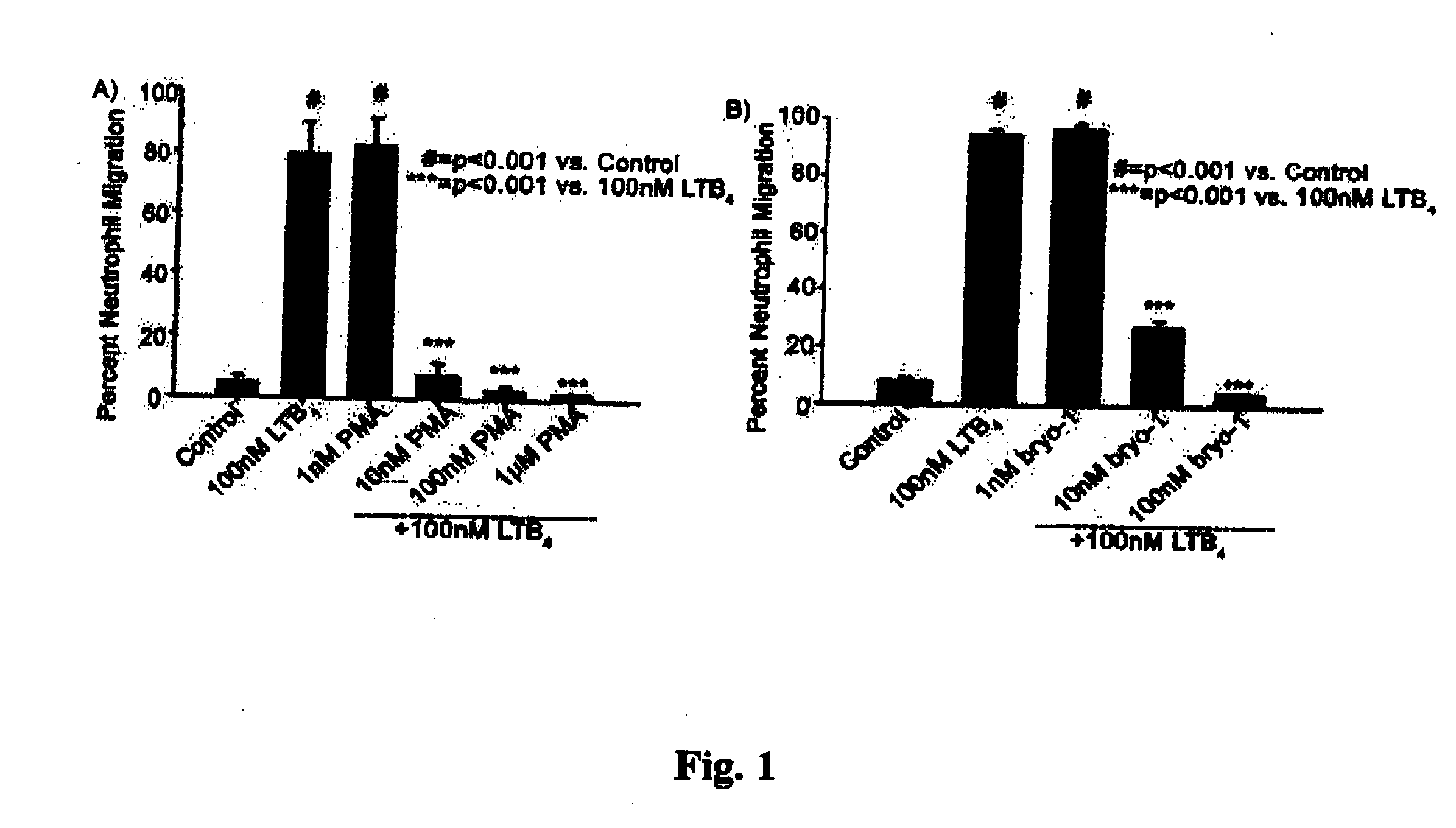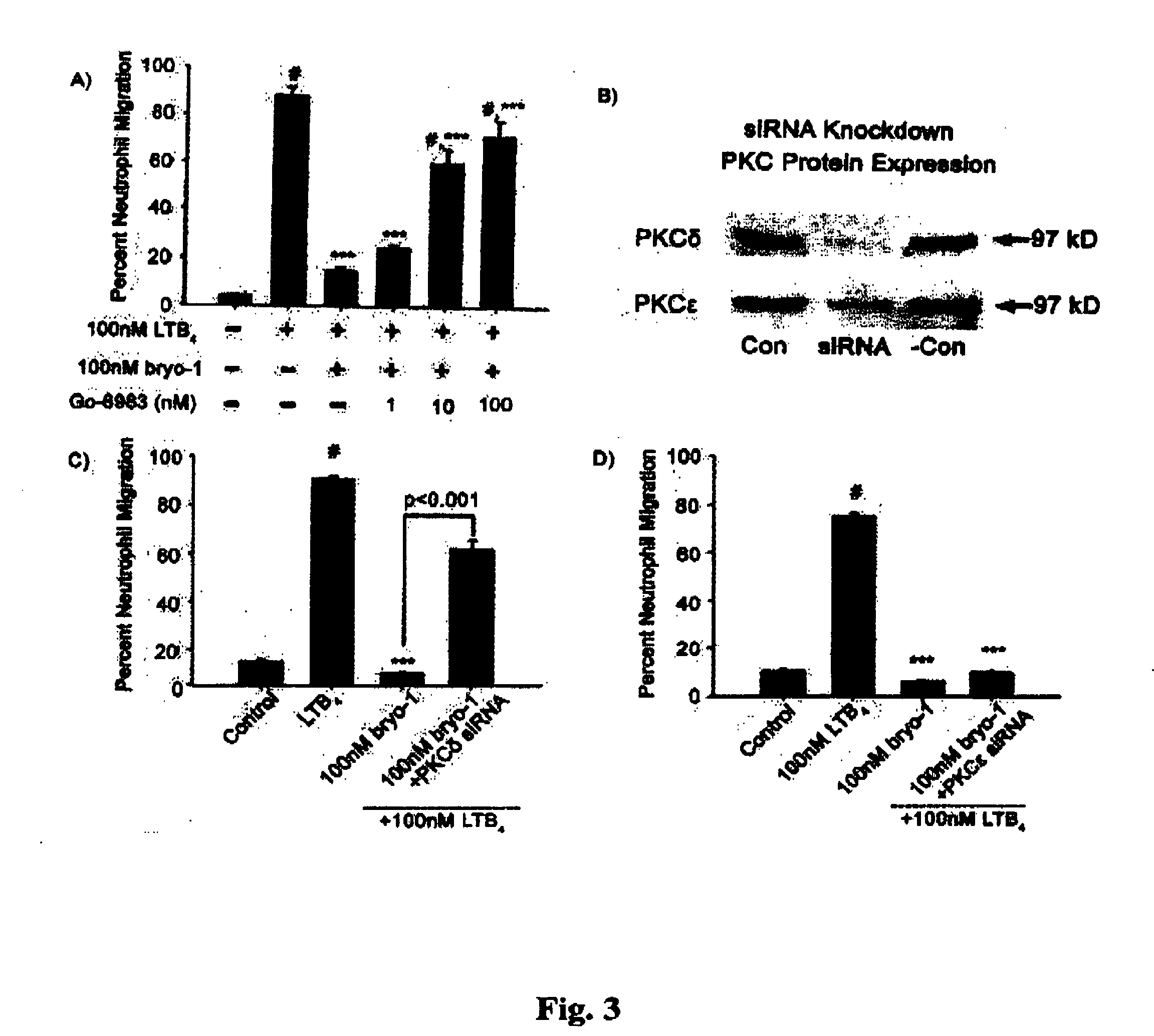Chronic inflammation and transplantation
a technology applied in the field of chronic inflammation and transplantation, can solve the problems that the role of endothelial second messengers and their possible regulation of neutrophil migration have not been investigated as extensively
- Summary
- Abstract
- Description
- Claims
- Application Information
AI Technical Summary
Benefits of technology
Problems solved by technology
Method used
Image
Examples
example 1
Second Messenger Reduction of Neutrophil TEM in Response to LTB4
[0053]The time scale of neutrophil adhesion to and migration through a HMEC monolayer is represented in FIG. 1.
[0054]A 100 nM concentration of LTB4 induces maximal adhesion at 1 hour accompanied by only a small increase in migration. As adhesion begins to decrease there is a corresponding increase in neutrophil migration. By 90 mins neutrophil migration is almost maximal and neutrophil adhesion has returned to baseline. To determine novel endothelial second messengers that could inhibit neutrophil transendothelial migration, endothelial cells were treated with a panel of pharmacological inhibitors and activators and alterations in neutrophil migration in response to LTB4 were observed.
[0055]Table 1 lists the drugs used to screen alterations in neutrophil migration and the effects of each drug on neutrophil adhesion and migration.
TABLE 1Second Messenger Alteration of Neutrophil Migration Induced by an LTB4 Gradient.Drug...
example 2
Type I and II Neutrophil TEM is Attenuated by PKC Activators
[0059]As shown in FIGS. 2 and 3, neutrophil migration was dramatically increased in response to a 100 nM LTB4 chemoattractant gradient in HMECs.
[0060]This increase was dose-dependently reduced upon 1 hour PMA or Bryostatin-1 pretreatment (FIGS. 2 and 3). Lower doses of PMA and Bryostatin-1 (1 nM) did not reduce PMN TEM, however, higher doses attenuated neutrophil TEM to levels below that of basal migration (100 nM). Because there are two types of neutrophil migration that are differentially regulated, we wanted to determine if PKC activators could also block neutrophil TEM induced by a cytokine. HMEC TNF-α stimulation for 24 hr induced significant increases in neutrophil migration (FIGS. 4 and 5).
[0061]Both PMA (100 nM) and Bryostatin-1 (100 nM) additionally attenuated Type II migration induced by 24 hr treatment with TNF-α (10, 20 ng / ml) (FIGS. 4 and 5). Also, PMA and Bryostatin pretreatments reduced migration induced by a...
example 3
Activation of PKCδ Reduces Neutrophil Migration in Response to LTB4
[0063]To insure that PMA and Bryostatin-1 effects were dependent on PKC activation, we tested various PKC inhibitors in the restoration of PMN TEM in response to LTB4. While Rottlerin (a PKCδ inhibitor), GF10923X (pan PKC inhibitor more potent for α, βI, βII, γ more potently), GO-6976 (inhibits PKCα and β with no effect on δ, e, ζ) and staurosporine (pan PKC inhibitor) did not restore PMN TEM, Go-6983 dose dependently restored neutrophil migration in response to LTB4 (FIG. 8). It has been suggested that different concentrations of Go-6983 inhibit different PKC isoforms. Lower concentrations (1 nM) have been suggested to inhibit classical PKC isoforms, while higher concentrations (10 nM) have been suggested to inhibit novel PKC isoforms.
[0064]Therefore we choose to investigate the roles of PKCδ and PKCε activation in inhibiting neutrophil TEM. PKCδ and ε siRNA were used to determine each isoforms role in this process...
PUM
| Property | Measurement | Unit |
|---|---|---|
| Weight | aaaaa | aaaaa |
| Time | aaaaa | aaaaa |
| Percent by mass | aaaaa | aaaaa |
Abstract
Description
Claims
Application Information
 Login to View More
Login to View More - R&D
- Intellectual Property
- Life Sciences
- Materials
- Tech Scout
- Unparalleled Data Quality
- Higher Quality Content
- 60% Fewer Hallucinations
Browse by: Latest US Patents, China's latest patents, Technical Efficacy Thesaurus, Application Domain, Technology Topic, Popular Technical Reports.
© 2025 PatSnap. All rights reserved.Legal|Privacy policy|Modern Slavery Act Transparency Statement|Sitemap|About US| Contact US: help@patsnap.com



